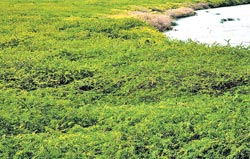
Bundala battles for survivalLike all tourist destinations in the country, the Bundala National Park is reeling from the drastic drop in visitor arrivals. But unknown to many, it is also fighting a far greater battle to save its precious flora and fauna from two invasive plants, which are literally smothering both at a great pace. According to members of the Bundala Inheritance Protection Organisation which represents 110 families from the Bundala village, an earlier Asian Development Bank funded project to eradicate the two alien plants Katu Andara (Prosipis Julifora) and pear cactus failed.
Park Warden Sisira Kumara de Silva, however, said since 2004 Mas Linea Aqua has been helping to fight the menace, later assisted by several other private sector organizations. It must, however be granted that the Bank has helped tremendously to improve facilities at the park for both its employees and the visitors. Among other improvements are that virtually all its employees are provided with modern living quarters and the park is equipped with a superb modern visitor centre to educate the visitors upon arrival of not only what is available in the park to see, but to give a general overview of the need to protect the environment. We ourselves observed quite a bit of uprooting of these invasive plants by bulldozer under the Mas project, which also employs about three dozen villagers to burn the uprooted material to arrest its spread. The country should be ever indebted to these companies for doing this silent yeoman service. But it appears the invasive plant is spreading faster than it is being destroyed, as only one bulldozer is being utilized for the project. Warden de Silva is of the opinion that it shouldn’t be speeded up either, as then there would be no vegetation cover for animals to survive. Both species of plant introduced by authorities in good faith during times of unprecedented drought, because they can withstand even the worst arid conditions, are now smothering other vegetation. Even giant palu trees are dying. But areas where the invasive plants have been removed some of these majestic trees have begun to sprout leaves once again. Mr. de Silva admits that 2/3 of the park is already covered by the two invasive plants. What is even worse about these plants is that animals too cannot survive amidst their smothering growth. As they are so thorny not even birds or elephants rest or traverse through them. They also spread so thoroughly and thickly, supplementing each other in covering the ground, eventually all animals will have no place in the park. We observed that especially areas surrounding the two lagoons within this sanctuary, were entirely covered like a thick carpet by these two invaders . |
|| Front
Page | News | Editorial | Columns | Sports | Plus | Financial
Times | International | Mirror | TV
Times | Funday
Times || |
| |
Copyright
2007 Wijeya
Newspapers Ltd.Colombo. Sri Lanka. |
